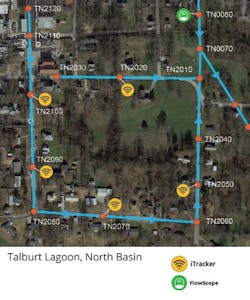For a small community, Greenfield, Mo., was plagued with what appeared to be major inflow and infiltration (I&I) problems. The sewer pipes were old and made of clay, and the area was rich with underground lakes. A 10,000-linear-ft sewer basin suspected of contributing major amounts of I&I had recently been replaced with all-new PVC pipe. Still, the I&I problem remained. In fact, it seemed to be getting worse.
Since the Talburt Lagoon North Basin was directly adjacent to the basin that had been recently rehabilitated, the community felt that it was now the cause of the ongoing problem. As can be seen from the sewer map, the Talburt Lagoon Basin ran from manhole TN2120 to manhole TN0070, at which point the flow merged with the recently rehabilitated basin culminating at manhole TN0080.
The Solution
Eastech offered to conduct a sewer evaluation study throughout the basin using its recently developed iTracking technology. Five iTrackers were strategically placed in manholes TN2100, TN2020, TN2050, TN2070 and TN2090. Even though Greenfield was confident that the I&I problem at the basin adjoining Talburt Lagoon had been solved by installing new PVC pipe, Eastech decided to confirm this belief by placing one of its high-performance cartridge flowmeters at the culmination of the remediated basin (Manhole TN0080).
The Results
The study lasted for a period of one month (Jan. 9 to Feb. 8, 2013), and the results surprised everyone. During the study period, two minor and two significant rainfall events occurred (.74 in. and 1.48 in.), providing infiltration markers for the period. During both rain events, sites TN2100 and TN2020 showed no signs of I&I. Dry-day flows for manholes TN2050, TN2070 and TN2090 were 3.15 gal per minute (gpm), 1.92 gpm and 1.28 gpm, respectively. During the Jan. 29 to 30 storm, TN2050 contributed a peak rain-derived I&I (RDII) of 14.88 gpm; TN2070 contributed a peak RDII 20.43 gpm; and TN2090 contributed a peak RDII of 22.05 gpm, for a total peak RDII of 57.36 gpm. Normally, dry-day flows at the Talburt Basin ran 6.95 gpm. Flows increased to 57.36 gpm during the peak RDII period.
The surprise came from the Eastech cartridge meter installed at the base of the newly renovated 10,000-linear-ft basin culminating at manhole TN0080. This basin normally produced average dry-day flows of 18 gpm. It was discovered that a consistent influx of groundwater infiltration of 55 to 60 gpm was present during dry-day periods. During the three rain events that took place from Jan. 10 to 14, the peak flow rose dramatically to 180 gpm, a tenfold increase from the average dry-day flow of 18 gpm. During the larger rain event of Jan. 29 and 30, the flows increased even more dramatically, reaching a peak of 383 gpm.
The municipality immediately initiated camera surveillance equipment only to discover that every joint within the newly installed PVC collection system was leaking profusely, allowing both ground- and storm water to enter on a continual basis.
Frank Sinclair is president of Eastech Flow Controls. Sinclair can be reached at [email protected].
